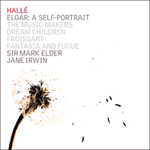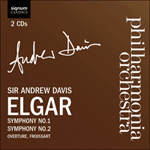
Welcome to Hyperion Records, a British classical label devoted to presenting high-quality recordings of music of all styles and from all periods from the twelfth century to the twenty-first.
Hyperion offers both CDs, and downloads in a number of formats. The site is also available in several languages.
Please use the dropdown buttons to set your preferred options, or use the checkbox to accept the defaults.

Yet it was probably the two most significant events of the previous year that prompted the 32-year-old composer to undertake this idealised portrait of knightly valour and fidelity to a lady-love: his marriage, and the overwhelming impression created by performances at Covent Garden of Die Meistersinger. The arresting opening of Froissart has the unmistakable imprint of Elgar, but the jaunty, dotted ‘knightly’ figure that pervades much of the overture’s thematic material can be traced back directly to the music with which Walther von Stolzing is introduced to the assembled mastersingers. Two things immediately impress in this astonishingly assured first essay in extended form: the music’s characteristic blend of ebullience and wistfulness, and the orchestration which already has in embryo all the distinguishing features that were so soon to earn the epithet ‘Elgarian’. The composer retained a lifelong affection for the work: revising the score for publication in 1901 he wrote to his friend Jaeger: ‘What jolly healthy stuff it is—quite shameless in its rude young health!’.
from notes by Hugh Priory © 1991
Ce sont cependant vraisemblablement les deux événements les plus importants de l’année précédente qui incitèrent le compositeur de trente-deux ans à entreprendre ce portrait idéalisé de valeur chevaleresque et de fidélité à une dame: son mariage, et la profonde impression qu’avaient eu sur lui les représentations à Covent Garden des Maîtres chanteurs. L’impressionnant début de Froissart porte la marque indubitable d’Elgar, mais le motif «chevaleresque» pointé désinvolte qui imprègne une grande partie du matériau thématique de l’ouverture a son origine directe dans la musique qui accompagne la présentation de Walther von Stolzing à l’assemblée des maîtres chanteurs. Deux choses frappent immédiatement dans ce premier essai à grande échelle étonnamment assuré: le mélange caractéristique d’effervescence et de désenchantement de la musique, et l’orchestration où l’on trouve déjà à l’état embryonnaire toutes les caractéristiques «elgariennes» distinctives. Le compositeur garda toute sa vie une affection spéciale pour cette œuvre: lorsqu’il révisa la partition pour sa publication en 1901, il écrivit à son ami Jaeger: «Quelle santé dans cette musique—la santé robuste et effrontée de la jeunesse!»
extrait des notes rédigées par Hugh Priory © 1991
Français: Elisabeth Rhodes
Höchstwahrscheinlich waren es die zwei bedeutsamsten Erlebnisse des vorangegangenen Jahres, die den 32jährigen Komponisten veranlaßten, dieses idealisierte Porträt von Ritterlichkeit und Minnetreue zu schaffen: seine Heirat und der überwältigende Eindruck, den mehrere Meistersinger-Aufführungen in Covent Garden auf ihn machten. Die fesselnde Eröffnung von Froissart mag unverkennbar Elgars persönliches Gepräge haben, doch die muntere punktierte „ritterliche“ Figuration, die immer wieder das thematische Material der Ouvertüre durchdringt, läßt sich direkt auf die Musik zurückführen, mit der Walther von Stolzing den versammelten Meistersingern vorgestellt wird. Zweierlei beeindruckt an diesem erstaunlich selbstsicheren ersten Versuch mit der erweiterten Form: die charakteristische Mischung von Überschwenglichkeit und Wehmut in der Musik und die Orchestrierung, die in embryonaler Form bereits alle besonderen Merkmale aufweist, die sehr bald das zusammenfassende Attribut „im Elgarschen Stil“ erwerben sollten. Der Komponist hegte eine lebenslange Zuneigung zu dem Werk: Als er die Partitur 1901 zur Publikation vorbereitete, schrieb er an seinen Freund Jaeger: „Was für schrecklich gesundes Zeug das ist—regelrecht schamlos in seiner frischen, jugendlichen Gesundheit!“
aus dem Begleittext von Hugh Priory © 1991
Deutsch: Anne Steeb/Bernd Müller
 Elgar: A self-portrait Elgar: A self-portrait BBC Music Magazine BBC Music Magazine‘This recording maintains the high standard that has been set, with a fascinating programme of music that ranges through Elgar's career … if Mark ...» More |
 Elgar: Symphonies Nos 1 & 2 Elgar: Symphonies Nos 1 & 2The Philharmonia Orchestra is widely recognized as the UK’s finest orchestra with an impressive recording legacy, this being their ninth release with Signum Records. This disc combines the Philharmonia’s renowned sound with the leadership of Maest ...» More |

